A History of the County of Hertford: Volume 3. Originally published by Victoria County History, London, 1912.
This free content was digitised by double rekeying. All rights reserved.
'Parishes: Bygrave', in A History of the County of Hertford: Volume 3, (London, 1912) pp. 211-217. British History Online https://www.british-history.ac.uk/vch/herts/vol3/pp211-217 [accessed 25 April 2024]
In this section
BYGRAVE
Biggrafan (x cent.); Bigrave (xi–xvii cent.).
The small compact parish of Bygrave, containing 1,793 acres, lies below the northern slope of the Hertfordshire chalk hills in the angle formed by the Icknield Way and the North Road through Barnet, which meet in the adjacent town of Baldock. On the north and east the boundary is formed by a road known as the Green Lane. The ecclesiastical parish was amalgamated with Baldock in 1901, (fn. 1) but Bygrave is still a distinct civil parish.
This parish is still uninclosed, and forms perhaps one of the most interesting examples in this country of a concentric mediaeval village of the Teutonic type of settlement. Although the lands are now all held by two or three farmers and the village community has been lost, the mediaeval arrangements are still clearly marked. The village is in the middle of the parish on high land. Like other early Teutonic settlements in this country it lies off the main road, about a mile and a half from the Roman road to the west and half a mile from the Icknield Way on the south. It is approached by roads or drifts uninclosed by hedges across the open fields from both these main roads, and by an inclosed road from Ashwell. The church stands in the highest part of the village, 314 ft. above the ordnance datum. Adjoining the churchyard on the south side is the site of the old fortified manor-house, (fn. 2) surrounded by a series of moats which, from indications on the ground, may have at one time inclosed the church. The modern rectory-house stands on the east of the church. The village lies to the northwest of the church along a broad street, which was evidently the market-place for the market which was established here by the Somerys in the 13th century. The attempt to make Bygrave a market town in competition with Baldock, then a new town on the more important site at the cross roads, was renewed by the Thornburys two centuries later. Along the village street are a few cottages and a house now called the Manor House, occupied as a farm by Mr. C. E. E. Cook.
The village is immediately surrounded by its inclosed pasture lands, which extend west and southwest to the road running south-westward to Baldock. The name 'Ploughed Warren' applied to certain arable land immediately east of a part of this road suggests that it was originally grass land also, which would make the pasture land more compact. On the eastern side of the pasture surrounding the village near the rectory is 'Park Wood,' which possibly marks the site of the inclosed lands attached to the Thornburys' house.
Beyond the pasture land are the great common fields which occupy not far short of 1,000 acres undivided by hedge or fence. They stretch in every direction upon the slopes which surround the village, and consist of open arable land broken into irregular strips of uneven size. There are two outlying farms in addition to the Manor Farm, and the occupiers of these, with other landowners, hold strips scattered over the whole area of the field. Parallel strips lie together in 'furlongs,' such as 'Miller's Furlong,' shown on the plan. This and other 'furlongs' generally abut on one of the broad field-paths. Where there is no road the plough is turned on transverse strips known as 'headlands.' In consequence the owner of the 'headland' must wait until the adjacent land is ploughed before ploughing his own. Sometimes the strips, and more often the furlongs, are divided by narrow grass banks known as 'balks.' Here and there, especially in the neighbourhood of the village, bushes growing on the balks have formed small hedges; but for the most part a single furrow is all that divides the strip of one occupier from that of his neighbour. The cottagers, as such, appear now to have no common rights over the open fields; but each occupier of arable land grazes his cattle over the whole field after harvest is gathered, the lord of the manor also having a right of sheep-walk for one month in May and October. This right is let with one of the farms, but it is not exercised, for the other occupiers purchase exemption. (fn. 3)
Bygrave has always possessed a very small population. There are now about thirty-one houses, and the population has increased between 1891 and 1901 from 99 to 148. (fn. 4) In 1428 the whole parish was said to contain only seven inhabitant householders. (fn. 5) The recent increase is due to the eastward extension of the town of Baldock around the station on the Cambridge branch of the Great Northern railway, which skirts the southern boundary of Bygrave, running parallel with the Icknield Way.
Near Baldock a small portion of the parish lies to the west of the North Road. It consists of some rough pasture, water-cress beds and rush-grown waste, and is traversed by the River Ivel. There can be little doubt that this extension over the Roman road, which would otherwise be the obvious boundary of the parish, was made by the early settlers with the object of obtaining the water-power from the Ivel to drive the manorial mill which certainly existed down to the 17th century. The pathway from the village which comes into the Roman road near to Blackhorse Farm or Blackhorse Mill is still known as Miller's Way. It was probably on this land to the west of the Roman high road in the neighbourhood of Baldock that there existed a glover's pit and 'Currier's' pasture early in the 17th century. (fn. 6) A part of Bygrave civil parish was annexed to Baldock in 1881. (fn. 7)
MANOR
Athelstan Atheling (born about 986), son of Ethelred the Unready, took BYGRAVE from a certain 'Leofmere,' but restored it by his will. (fn. 8) In the time of Edward the Confessor 'Lemar' (the same name as Leofmere) (fn. 9) held it. He was a man of Archbishop Stigand, but could alienate his land without the archbishop's licence. In 1086, however, Robert (de Limesey),the recently consecrated Bishop of Chester and Lichfield, held the manor in demesne. There were also two sokemen there holding 3 virgates which they had been unable to alienate in the Confessor's time without the leave of the archbishop. (fn. 10) Robert de Limesey probably held the manor as his personal property, as he did North Mimms. (fn. 11) Like that manor it became attached at an early date to the honour of Gloucester. (fn. 12) It is possible that Limesey died without heirs, and that his lands were granted to the Earls of Gloucester. Bygrave was held of the honour by Miles de Somery as three knights' fees and a half in 1201. (fn. 13) In later records the service due for Bygrave is variously stated as two knights' fees, (fn. 14) one fee, (fn. 15) and half a fee. (fn. 16) The honour was vested in the Crown by the marriage of Anne, heiress of the Despensers, with Richard III, and in 1678 a rent of one-tenth was still reserved to the Crown. (fn. 17)
It seems possible that Miles de Somery had been preceded by Elias de Somery. (fn. 18) Miles de Somery evidently made sub-enfeoffment of the manor to another member of his family before his death, which occurred before 1229, (fn. 19) for in 1220 Hugh de Somery conveyed Bygrave to John de Somery in consideration of an annuity of 16 marks. (fn. 20) Upon the death of Stephen, son and ultimate heir of Miles de Somery, the service from Bygrave was assigned to his widow Joan in dower, (fn. 21) and it afterwards passed to Richard de Bachesworth, (fn. 22) one of the sons of Maud, sister and co-heir of Stephen de Somery. (fn. 23) No later trace of the mesne lordship has been found.
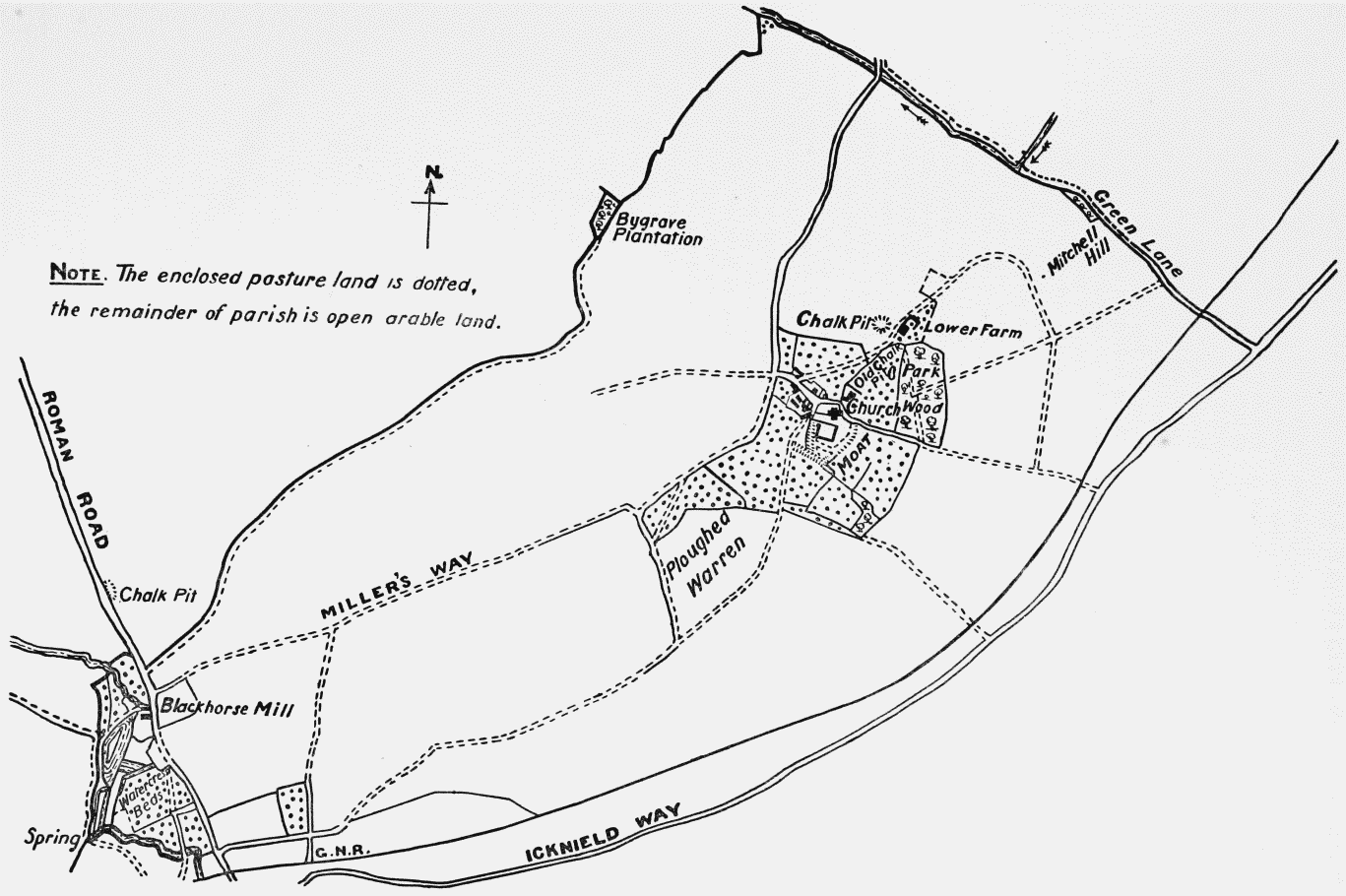
Map of Bygrave Parish
John de Somery was succeeded as tenant of the manor by Adam de Somery, who had a grant of a market, fair and free warren on 20 October 1256. (fn. 24) His widow Margery claimed dower in Bygrave in 1272. (fn. 25) His heir appears to have been another Adam de Somery, who gave a life interest in the manor to Master John de Wengham, Precentor of St. Paul's. (fn. 26)
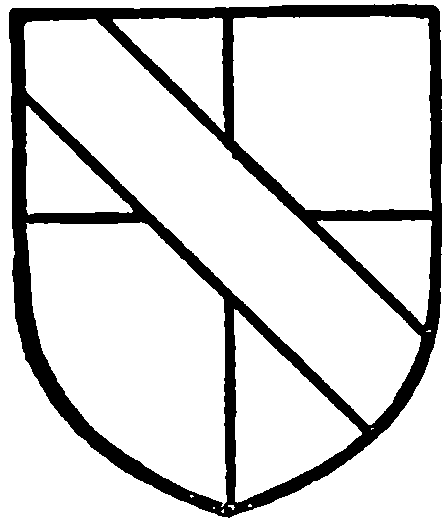
Somery. Quarterlyor and azure a bend gules.
In 1287 the manor was again alienated from the direct line of the Somery family. Adam de Somery granted his reversionary rights upon the death of John de Wengham to John son of John de Somery, reserving only to himself and his own son John two mills, 4 acres of meadow and 100s. rent. (fn. 27) John son of Adam was in 1312 charged with breaking the park of the Earl of Pembroke at Bishop's Hatfield. (fn. 28) It is not clear whether it was this John de Somery or the actual lord of the manor (John son of John) who as 'John de Somery of Bygrave' received pardon in October 1313 for adherence to the party of Thomas of Lancaster and complicity in the murder of Piers Gaveston. (fn. 29)
The manor was held in 1327 by Sir Richard de Somery, kt., possibly the heir of John son of John. He then settled it upon himself and his wife Elizabeth. (fn. 30) According to the statement of Richard de Somery, Robert de Prestbury, the king's yeoman, (fn. 31) and others of his ill-wishers came to his manor and carried off goods and chattels, horses, oxen, sheep and pigs to the value of £200. This they did under the pretext that he was an ally of Robert de Baldock the chancellor, who in 1326 suffered imprisonment for his support of the Despensers. Somery maintained that he had even suffered grievous wrong at the hands of Baldock, and prayed the king to compensate him from the profits of Orwell Manor (co. Cambs.), the custody of which had been given to the same 'Master' Robert [? de Baldock]. (fn. 32)
Richard de Somery was succeeded by his son John, to whom a certain Geoffrey Somery surrendered all right in the manor on 8 June 1349. (fn. 33) In 1357 John de Somery settled the manor upon himself and his wife Margery (or Margaret) for life with remainder to their son John in tail-male and remainder in default of heirs male to their daughter Elizabeth. (fn. 34) Margery de Somery seems to have survived her husband and her son and to have taken a second and a third husband, Sir John Maynard, kt., (fn. 35) and Thomas Paynell. (fn. 36) The daughter Elizabeth married Sir William de Elington, kt. (fn. 37) In 1379 Sir Alexander de Walden, kt., and his wife Elizabeth (probably Elizabeth Somery) (fn. 38) made a settlement of the manor upon themselves and their heirs with contingent remainder to the right heirs of Elizabeth. (fn. 39) Four years later they sold Bygrave to Sir John Thornbury, (fn. 40) the 'king's knight,' (fn. 41) and one of his justices of the peace in Hertfordshire. (fn. 42)
In 1386 Thornbury had licence to crenellate his two houses within the manor of Bygrave. (fn. 43) He served as commissioner of array in the county in 1392 when it was feared that the expiration of the truce with France might be followed by invasion. (fn. 44) He was succeeded before 1428 by Sir Philip Thornbury, kt., (fn. 45) who in 1435 obtained confirmation of the liberties formerly granted to Adam de Somery. (fn. 46) In 1457 Thornbury settled the manor upon himself for life with remainder to his daughter Margaret and her husband Nicholas Appleyard; after their death it was to pass to their son John in tail-male with contingent remainder to the heirs male of Margaret. (fn. 47)
John Bensted, heir of Edward Bensted (who had apparently held the manor in trust for either John or Philip Thornbury), (fn. 48) surrendered all claim in it to Nicholas and Margaret Appleyard in 1458. (fn. 49) Roger, son of a Nicholas Appleyard, inherited the manor from his father and died seised of it in 1528, leaving an infant son John. (fn. 50) In 1550 this John Appleyard with his wife Elizabeth conveyed the manor to Hugh Stukeley, gent., of London, (fn. 51) evidently agent in a sale to Laurence Warren and his wife Joan. (fn. 52) The latter survived her husband, who died 4 August 1556. (fn. 53) Their son William Warren apparently took the name of 'Bygrave,' for in the visitation of 1586 'Jane' (for 'Juliana') Needham is said to have married William 'Warren alias Bygrave.' (fn. 54) He settled an annuity out of the manor upon her, and died 3 February 1588–9, leaving a young son William. (fn. 55) The latter entered upon the manor about 1602. (fn. 56) During his long minority his debts had accumulated and he was further burdened with the maintenance of his brothers and sisters. In order to make fitting provision for them he sold Bygrave Manor about 1613 to William Whettell of Thetford and Sir John Heveningham, kt., (fn. 57) of Ketteringham, Norfolk, endeavouring to raise the price by hints that the estate was desired in high quarters. Warren had apparently resided at Bygrave, only moving to London after its sale; but to Whettell the value of the estate was diminished by its distance from his own home, yet he refused to accept Warren's offer to retain the 'mansion house dovehouse buildings gardens and orchards' on a ten years' lease. (fn. 58) Whettell seems to have transferred all his rights to Sir John Heveningham, for whom he may possibly have acted from the beginning. (fn. 59)
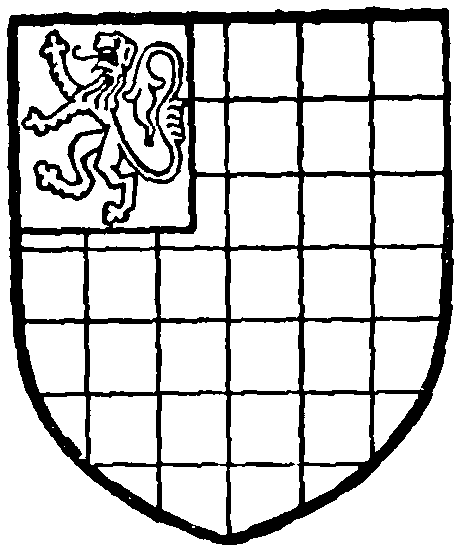
Warren. Checky or and azure a quarter gules with a lion argent therein.
In November 1627 Sir John Heveningham was imprisoned with Sir Thomas Darnel and others, by special command of the king, for refusing to contribute to a forced loan. (fn. 60) This case was among the immediate causes of parliamentary assertion of the liberty of the subject in the Petition of Right. Released in January 1627–8, Sir John Heveningham settled Bygrave on his eldest son William in the following March. (fn. 61)
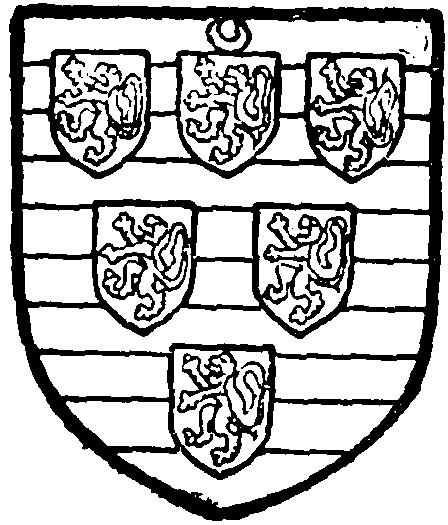
Cecil, Marquess of Salisbury. Barry of ten pieces argent and azure six scutcheons sable with a lion argent in each differenced with a crescent.
Upon Sir John's death in 1633 the estate passed to William Heveningham, who took sides with the Parliament at the outbreak of the Civil War. He was a member of the court nominated to try the king, and was present 22, 23 and 27 January 1649, when sentence was confirmed, but he refused to sign the death-warrant. (fn. 62) In 1651 he sold Bygrave to Francis Cleaver, citizen and draper of London, (fn. 63) who already resided in the parish. (fn. 64) He transferred the estate to his son Charles Cleaver, (fn. 65) who was knighted at Whitehall 7 June 1660. (fn. 66) It was, however, seized by the Crown with the other lands of William Heveningham the regicide, owing to some flaw in the conveyance to Francis Cleaver. (fn. 67) Sir Charles petitioned for its restoration 4 June 1663, and received a grant from the Crown six days later. (fn. 68) About 1682 he sold the manor at the (then) large price of £13,000 to James third Earl of Salisbury, who thus consolidated his estate in the neighbourhood of 'Quicksett Hill.' (fn. 69) Bygrave has since remained with the direct descendants of the earl. (fn. 70)
There was probably a mansion or manor-house at Bygrave at an early date. Possibly it was at the house of Master John de Wengham that Edward I stopped on his way to St. Albans in January 1299 and April 1302. (fn. 71) It has been shown that a John de Somery was resident at Bygrave in 1313. (fn. 72) In 1386, as already stated, Sir John Thornbury seems to have had two houses at Bygrave. (fn. 73) The mansion house in which William Warren lived (fn. 74) was probably the capital messuage sold with the manor and with Bygrave Farm to Francis Cleaver in 1651. (fn. 75) Manorial works still exist at Bygrave House and at the adjacent site of the so-called 'Palace.'
The lords of Bygrave had court baron, but the Crown held the view of frankpledge by the sheriff, who either received 5s. or at his departure 'partook with the lord of whatever stood on the table.' (fn. 76)
The market granted to Adam de Somery in 1256 was held on Mondays. The fair lasted three days, beginning on the eve of the feast of St. Margaret. (fn. 77) The date of the fair had been changed by 1880; it was then held on Easter Monday. (fn. 78) It is now extinct. In 1286 John de Wengham claimed amendment of assize of bread and ale. He likewise made good the right of the lord to infangtheof and gallows, and asserted a claim to pillory and tumbrel. (fn. 79)
Free warren was also granted to Adam de Somery in 1256, and with the market and fair was confirmed to Sir Philip Thornbury in 1435, and the right of free warren is recited in later records relating to the manor. (fn. 80) John de Wengham twice complained of persons who fished in his stews at Bygrave. (fn. 81) Free fishing is mentioned as pertaining to the manor in 1658. (fn. 82)
In 1086 there was one water mill at Bygrave, (fn. 83) possibly on the River Ivel, near Baldock. Two mills were reserved by Adam de Somery in granting the manor to John son of John de Somery in 1287, (fn. 84) but a water mill belonged to the manor at the death of Laurence Warren. (fn. 85) It was excepted from the sale to Sir John Heveningham. (fn. 86) No mill exists at present.
Monks' Lands
MONKS' LANDS, an estate comprising a house and 500 acres of land (measuring 16 ft. to the perch), (fn. 87) with a roadway from the land, was acquired by Adam the Cellarer of St. Albans from William 'de Wedona ' at an unknown date. The estate is at the same time enumerated among the lands acquired by Adam the Cellarer from Elias de Somery. It is therefore possible that William de Wedona held the land of Elias as lord of the manor. Henry II confirmed this gift between the years 1174 and 1182, and the profits were assigned to the use of the monks' kitchen. (fn. 88) As early as 1291 the estate was let out to farm. (fn. 89) The yearly rent was then £6 9s. 4d. By 1526 the house was demolished and the lands let to Roger Appleyard, the lord of the manor, on a twenty-one years' lease. (fn. 90)

St. Albans Abbey. Azure a saltire or.
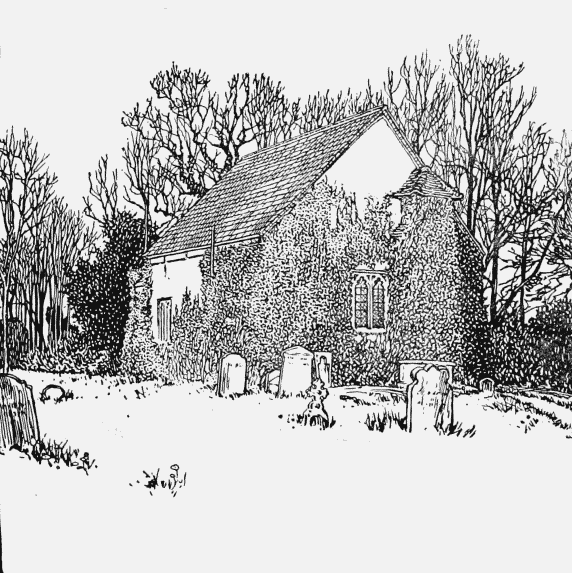
Bygrave Church from the North-west
The abbey surrendered to the Crown 5 December 1539. (fn. 91) In February 1543 50 acres of meadow and pasture called Monks' Lands were granted to Sir John Williams and Sir Edward North, treasurer of the Court of Augmentations. (fn. 92) Six months later (26 August 1543) the toft with lands called Monks' Lands was granted to Thomas Godwin. (fn. 93) Both had been leased to John Bowles. The toft and garden commonly called Monks' Lands subsequently came into the possession of Nathaniel Disborrow, son of John Disborrow of Eltisley, co. Cambs., who sold them to William Whettell. The estate was thus united to the manor of Bygrave. (fn. 94)
CHURCH
The church, of unknown dedication, (fn. 95) consists of a chancel 25 ft. 6 in. by 14 ft. 6 in., nave 31 ft. by 20 ft. 6 in., and south porch 6 ft. by 5 ft. All dimensions are taken internally. The church is cemented on the outside, the dressings being of stone and the roofs tiled.
The nave is the earliest part of the church, and belongs to the 12th century, the chancel to the latter part of the 14th century, and the west turret to the 15th century, when the windows were altered and the rood stair was built.
The east window is transomed and has three cinquefoiled lights, traceried in the head. In the north wall is a small 14th-century door, and beside it a low-side window of one cinquefoiled light; the only other window is of two cinquefoiled lights set under a square head. In the south wall are two windows, one a window of two lights similar to that on the north side, the other of three cinquefoiled lights under a four-centred arch. On the south side of the chancel is a 14th-century moulded and arched piscina, and on the north side is an arched niche for a tomb. The chancel arch is of two moulded orders, with engaged shafts under.
The nave has a window in each of its north, south and west walls consisting of two cinquefoiled lights under square heads. The doorway to the rood stair is set in a splay on the north side of the chancel arch; the stair and openings to the rood loft still remain. The north doorway has been blocked; the south doorway is of the 12th century, but is much restored. The arched head is slightly pointed and has the roll moulding. There are shafts in the jambs with scalloped heads, but the whole has been much restored. The south porch is of 18th-century work.
There is a small semioctagonal turret against the west wall on the south side of the west window which gives access to the bell.
The font belongs to the 15th century; it is octagonal, standing on a square base. The sides of the basin have rectangular sunk panels, carved with the instruments of the Passion; round the stem are angels holding shields. The wooden cover is a bastard Gothic of perhaps the 18th century.
The rood screen is of the 15th century, the upper part having open tracery work, the lower closed panels being traceried. There is a carving of the royal arms on the cornice of the screen of late 17th-century work. The communion table and rails also belong to the 17th century.
There are some traceried panels of the 15th century incorporated with the modern pulpit, and fixed to the pulpit is a 17th-century wrought-iron hour-glass stand. There are some 15th-century bench ends with poppy heads in the church and some plain old seating. Some fragments of 15th-century glass still exist in the nave windows, and in the churchyard by the west wall of the church is an old stone coffin without a lid.
The bell is dated 1718, but has no maker's mark.
The communion plate is a modern set presented by the rector, the Rev. J. H. Carnegie, in 1873.
The surviving registers are in two books: (i) baptisms from 1802 to 1805, burials 1805 to 1808; (ii) marriages 1765 to 1808. The earlier books were accidentally destroyed by fire.
ADVOWSON
The church was given to the monks of St. Albans by William de Wedona and assigned with Monks' Lands to the use of the kitchen. (fn. 96) The assignment was confirmed by the pope in 1218. (fn. 97) No appropriation took place, (fn. 98) however, and in 1220 it was John de Somery, lord of the manor, who presented a rector. (fn. 99)
The right of John de Somery to the advowson is not clear, but the successive lords of the manor subsequently presented when the church became void, and the patronage of the church continued with them until 1901, when the parish was united to that of Baldock. (fn. 100)
The case of an early rector of Bygrave shows the lawless condition of the country. John Legat, rector, it was presented in 1381, went to the house of John de Walden, probably a relative of Sir Alexander de Walden, for a time lord of the manor, and with his chaplain William Huberd and others beat and killed John de Walden and threw his body into the highway. (fn. 101)
In 1608 George Coke, brother of Sir John Coke, 'using but his purse and labours,' became rector of Bygrave. (fn. 102) While parson there he purchased a little land at Baldock 'upon twenty-six years' frugality' (fn. 103); but Archbishop Laud blamed him for leaving the parsonage 'stark nought and unfit for any man's habitation' (fn. 104) when he was consecrated Bishop of Bristol 10 February 1632–3.
Another notable incumbent was John Savage, the historian, who held the living from 1701 to 1708, when he resigned it for the more valuable benefice of Clothall. (fn. 105)
There are no schools or endowed charities at Bygrave.
